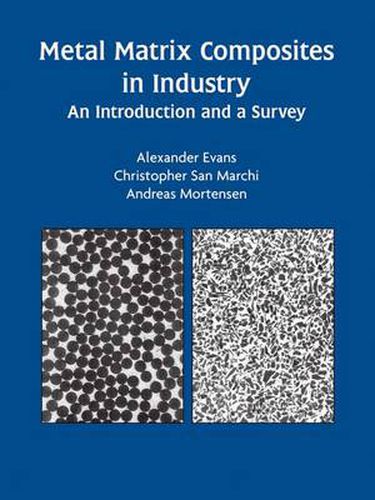Readings Newsletter
Become a Readings Member to make your shopping experience even easier.
Sign in or sign up for free!
You’re not far away from qualifying for FREE standard shipping within Australia
You’ve qualified for FREE standard shipping within Australia
The cart is loading…






This title is printed to order. This book may have been self-published. If so, we cannot guarantee the quality of the content. In the main most books will have gone through the editing process however some may not. We therefore suggest that you be aware of this before ordering this book. If in doubt check either the author or publisher’s details as we are unable to accept any returns unless they are faulty. Please contact us if you have any questions.
Metal matrix composites are making tangible inroads into the real world of engineering. They are used in engineering components such as brake rotors, aircraft parts, combustion engines and heat sinks for electronic systems. Yet outside a relatively limited circle of specialists, these materials are mostly unknown. Designers do not as a rule think of using these materials, in part because access to information is difficult as these materials have not really entered engineering handbooks. This volume should be useful to engineers who wish to gain introductory knowledge of metal matrix composites and who want to know where to find them. Additionally, it provides researchers and academics with a survey of early-21st century industrial activity in this area of technology. The book is divided into two parts: the first consists of a brief introduction to metal matrix composites, written at an elementary level; and an explanation of the database and how it was assembled. It ends with a few conclusions that emerge from the exercise concerning the metal matrix composites industry as it now stands. The second part outlines the real world activity in metal matrix composites, using text and tables, which are also provided in searchable form on disk as three interlinked Filemakers. The book and database list about 140 companies active in metal matrix composites, 170 examples of these materials actually used or produced, and 90 products available on the market. Two features of this work make it a valuable industry and academic reference: the landscape of the MMC industry as it stands in 2003 is presented: a global survey, not exhaustive, but reasonably complete, with sufficient detail to provide the reader with an accurate description of the commercial activities in this new and growing branch of materials technology. A relatively user-friendly introduction to these materials is provided for engineers who might consider using them, but who are not specialists.
$9.00 standard shipping within Australia
FREE standard shipping within Australia for orders over $100.00
Express & International shipping calculated at checkout
This title is printed to order. This book may have been self-published. If so, we cannot guarantee the quality of the content. In the main most books will have gone through the editing process however some may not. We therefore suggest that you be aware of this before ordering this book. If in doubt check either the author or publisher’s details as we are unable to accept any returns unless they are faulty. Please contact us if you have any questions.
Metal matrix composites are making tangible inroads into the real world of engineering. They are used in engineering components such as brake rotors, aircraft parts, combustion engines and heat sinks for electronic systems. Yet outside a relatively limited circle of specialists, these materials are mostly unknown. Designers do not as a rule think of using these materials, in part because access to information is difficult as these materials have not really entered engineering handbooks. This volume should be useful to engineers who wish to gain introductory knowledge of metal matrix composites and who want to know where to find them. Additionally, it provides researchers and academics with a survey of early-21st century industrial activity in this area of technology. The book is divided into two parts: the first consists of a brief introduction to metal matrix composites, written at an elementary level; and an explanation of the database and how it was assembled. It ends with a few conclusions that emerge from the exercise concerning the metal matrix composites industry as it now stands. The second part outlines the real world activity in metal matrix composites, using text and tables, which are also provided in searchable form on disk as three interlinked Filemakers. The book and database list about 140 companies active in metal matrix composites, 170 examples of these materials actually used or produced, and 90 products available on the market. Two features of this work make it a valuable industry and academic reference: the landscape of the MMC industry as it stands in 2003 is presented: a global survey, not exhaustive, but reasonably complete, with sufficient detail to provide the reader with an accurate description of the commercial activities in this new and growing branch of materials technology. A relatively user-friendly introduction to these materials is provided for engineers who might consider using them, but who are not specialists.